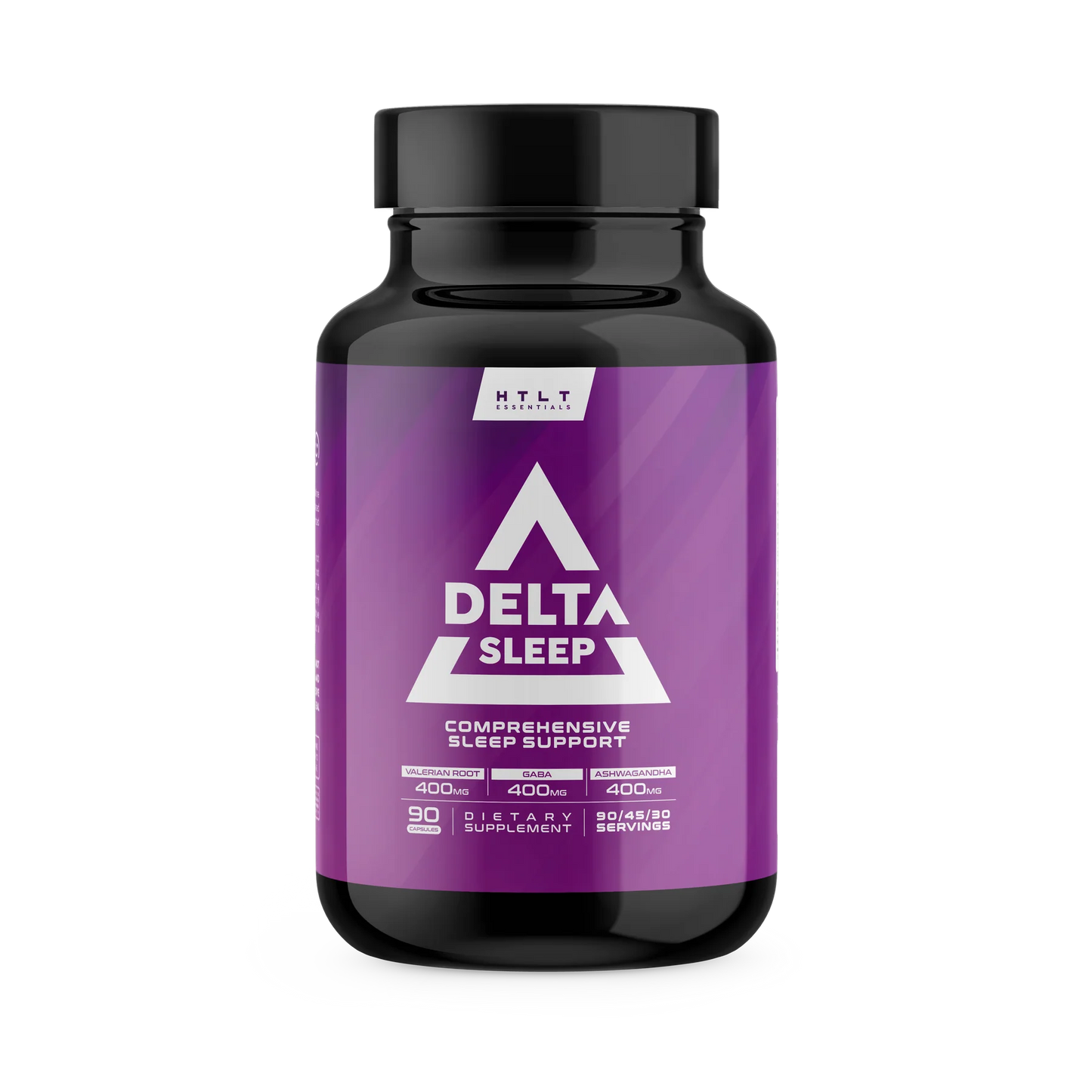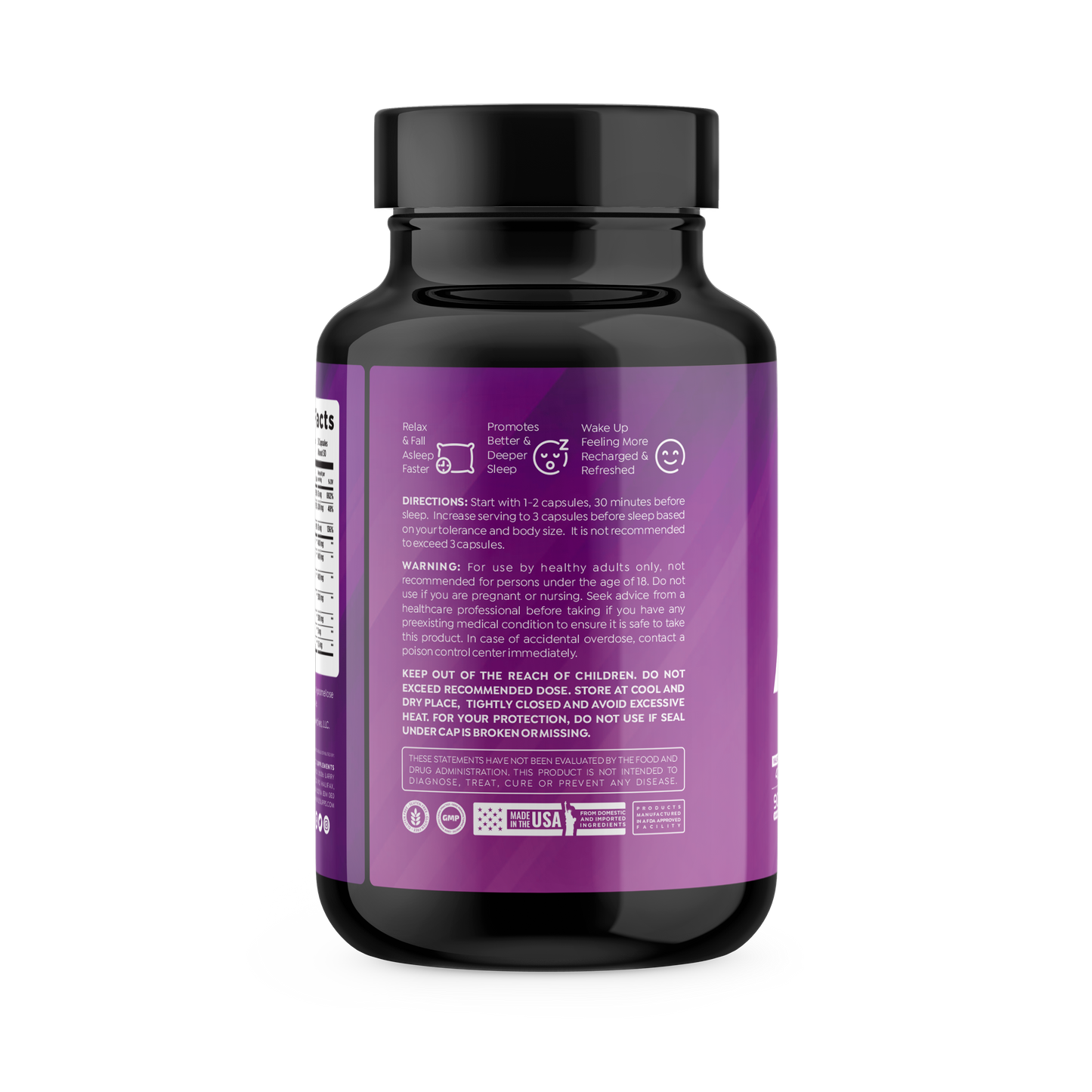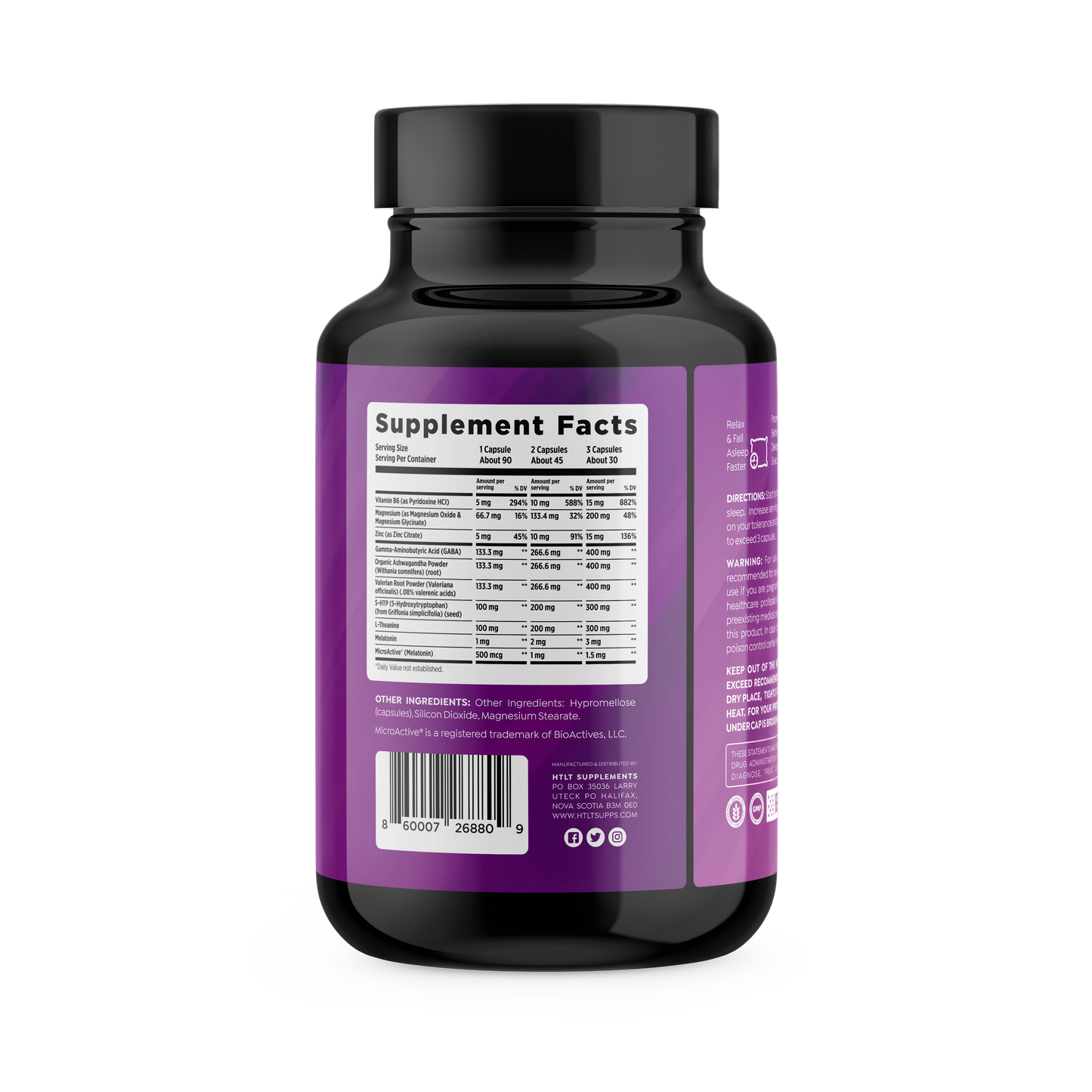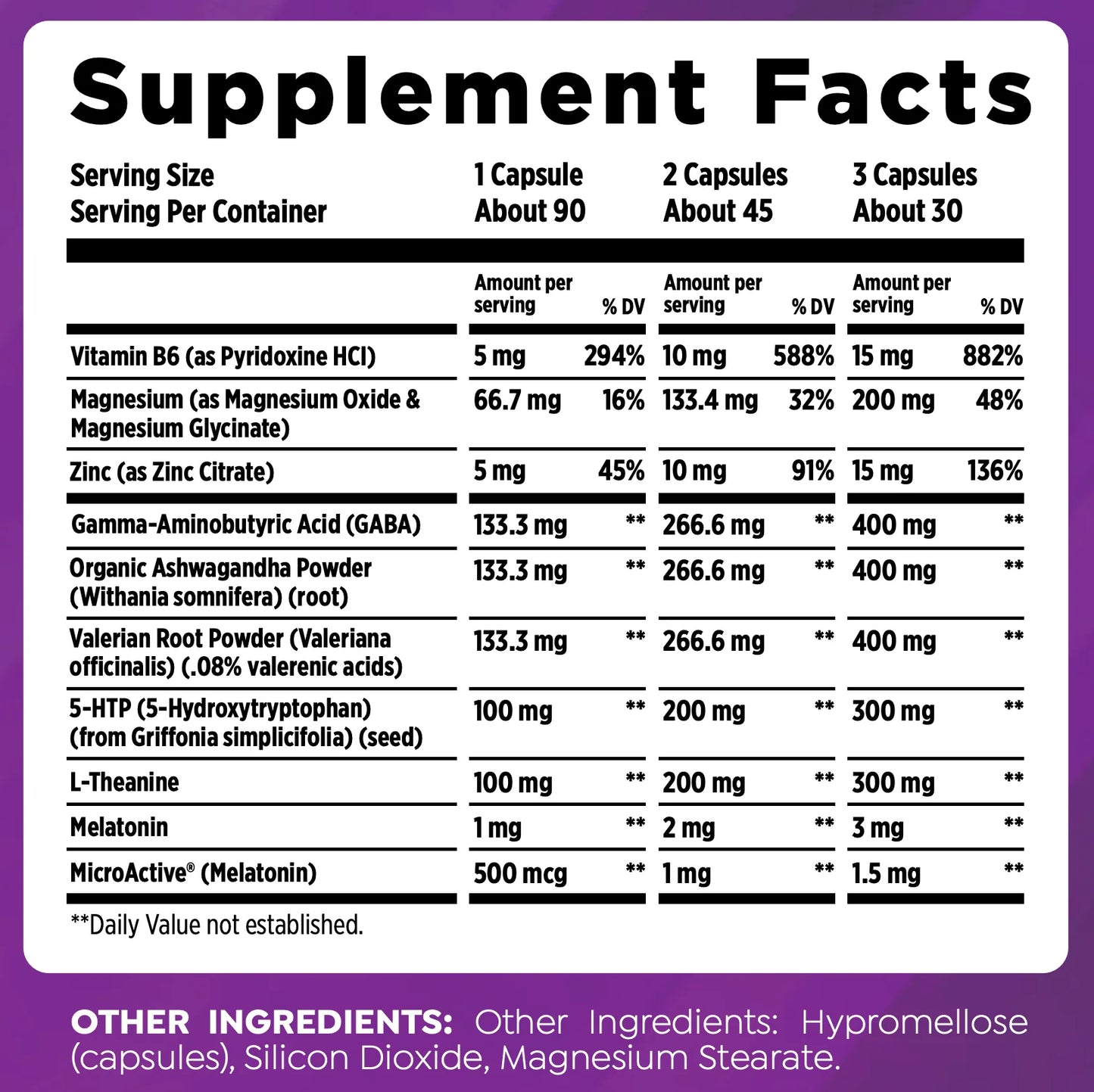HTLT Delta Sleep Formula
HTLT Delta Sleep Formula
Couldn't load pickup availability
Sleep Better Than Last Time!
HTLT Delta Sleep was built to be a premium sleep product you can rely on. It works by helping relax the body and mind first, helping you fall asleep faster, and then helping you stay asleep for a restful night. Sleep is vital to our body's recovery. It's time you started sleeping BETTER than last time!
Our ingredients are sourced from premium suppliers and third-party lab tested to ensure the best possible quality product. Learn more about our formula below:
Relax | Sleep | Wake Up Refreshed
Ingredients
Ingredients
NADH is the reduced form of NAD+, a compound that exists within our body that has been supported in a recent meta-analysis to be an excellent supplement for ameliorating fatigue, providing the greatest benefits in those who suffer from chronic fatigue syndrome [2].
NADH is taken up by the mitochondria and is a critical component in generating cellular energy (functioning as an electron transporter in the electron transport chain).
NADH has also been supported to:
- Increase the production of dopamine
- Increase general quality of life
- Reduce symptoms of anxiety
- Increase maximum achievable heart rate during exercise secondary to an increase in work capacity
As the body utilizes one molecule of NADH, 3 molecules of ATP and one molecule of NAD+ are produced. This means that you can expect to see an increase in power output and endurance with this cutting-edge ingredient.
Saffron Extract possesses potent mood boosting properties. With dozens of RCTs (randomized controlled trials) being conducted on saffron extract on a yearly basis, it is established as a safe and effective compound in improving one's mood and cognition [4].
Through increasing serotonin levels in the brain, it has shown comparable efficacy to Fluoxetine (SSRI) without the associated anhedonia or weight gain frequently seen with SSRIs, additionally, saffron has robust evidence supporting it as a weight loss agent through suppressing one's appetite and improving glucose tolerance (this effect is more pronounced in those who are overweight and/or obese) [4].
N,N-Dimethylphenylethylamine (N,N-DMPEA) is a compound initially discovered in the Eria Jarensis orchid and used as flavoring compound (described as sweet & fishy), being recognized by the World Health Organization for this purpose [7]. Interestingly, the compound is a substituted phenylethylamine (PEA) and also a TAAR1 agonist like PEA [6].
In comparison to PEA, it contains two additional methyl groups, which allows the compound to persist for longer periods before being cleaved and metabolized by the MAO-B enzyme which works to break down / eliminate trace amines from the body.
You may experience a slight euphoria from this ingredient, many people describe it as a 'buzz'.
Beta Alanine is an incredibly effective oral agent for the purposes of increasing muscle carnosine levels and work capacity under load; being especially noticeable in high rep ranges and bouts of near-maximal cardio [21].
There has also been a measurable improvement in cognitive performance in athletes supplementing with Beta Alanine, as it directly activates sensory neurons; causing a temporary itch sensation (paresthesia) which many find to be quite enjoyable / stimulating [22, 21].
Citicholine (CDP-Choline) is one of the only cholinergic compounds shown to boost psychomotor speed and increase dopamine production, it is indeed an expensive and valuable ingredient for improving performance and cognition [8,9]. CDP Choline is not only an excellent choline source, it is also a source of Uridine which appears to have unique cognitive enhancing effects [9].
Alpha GPC is amongst the best sources of choline, increasing acetylcholine levels in the brain and improving power output in athletes. Acetylcholine is necessary in the triggering of synapses, being used in the neuromuscular junction to trigger the firing of motor neurons [10,11].
This may also result in increased muscle fiber recruitment / mind-muscle connection, improved learning abilities and a greater attention span [11].
DMAE is a unique source of choline which has been shown to be effective in reducing the accumulation of the harmful pigment ‘lipofuscin’ in the body, this pigment increases with age and is associated with some neurodegenerative disorders like Alzheimer's and dementia [12].
Taurine is a non proteinogenic amino acid which plays a role in regulating fluid balance and neurochemistry. Taurine promotes cell volume homeostasis, helping in situations of dehydration / fluid retention thus positively affecting fluid balance [14,15].
Taurine increases activity of the GABA-A receptor which may explain why it synergizes well with caffeine and other stimulants, by 'taking the edge off' certain stimulants.
Taurine has been shown to improve athletic performance and increase the tolerability of caffeine by ameliorating some of the vasoconstricting properties some may experience with stimulants [13,15].
Caffeine Anhydrous is a central nervous system stimulant found in nature and is also classified as a drug of the methylxanthine class. It promotes wakefulness, enhances physical performance, promotes weight loss and increases feelings of wellbeing if dosed correctly [16].
Individual responses to caffeine may vary significantly amongst individuals as some have greater tolerance or are rapid metabolizers, in which caffeine doesn't affect them as greatly; while some are slow metabolizers or are simply just caffeine naive. It is best to start at one scoop to assess tolerance and not to exceed the maximum 3 scoop serving size.
Huperzine A is the active component in Huperzia Serrata extract. Huperzine A partially inhibits acetylcholinesterase, the enzyme that breaks down acetylcholine; this inhibition can lead to greater levels of acetylcholine in the synaptic cleft and has translated into improved cognitive performance in several randomized controlled trials [18,19].
Research
Research
- O'Brien, C., Mahoney, C., Tharion, W. J., Sils, I. V., & Castellani, J. W. (2007). Dietary tyrosine benefits cognitive and psychomotor performance during body cooling. Physiology & behavior, 90(2-3), 301–307. https://doi.org/10.1016/j.physbeh.2006.09.027
- Gindri, I. M., Ferrari, G., Pinto, L. P. S., Bicca, J., Dos Santos, I. K., Dallacosta, D., & Roesler, C. R. M. (2023). Evaluation of safety and effectiveness of NAD in different clinical conditions: a systematic review. American journal of physiology. Endocrinology and metabolism, 10.1152/ajpendo.00242.2023. Advance online publication. https://doi.org/10.1152/ajpendo.00242.2023
- Druml, W., Lochs, H., Roth, E., Hübl, W., Balcke, P., & Lenz, K. (1991). Utilization of tyrosine dipeptides and acetyltyrosine in normal and uremic humans. The American journal of physiology, 260(2 Pt 1), E280–E285. https://doi.org/10.1152/ajpendo.1991.260.2.E280
- Lu, C., Ke, L., Li, J., Zhao, H., Lu, T., Mentis, A. F. A., Wang, Y., Wang, Z., Polissiou, M. G., Tang, L., Tang, H., & Yang, K. (2021). Saffron (Crocus sativus L.) and health outcomes: a meta-research review of meta-analyses and an evidence mapping study. Phytomedicine : international journal of phytotherapy and phytopharmacology, 91, 153699. https://doi.org/10.1016/j.phymed.2021.153699
- Cremonte, M., Sisti, D., Maraucci, I., Giribone, S., Colombo, E., Rocchi, M. B. L., & Scoglio, S. (2017). The Effect of Experimental Supplementation with the Klamath Algae Extract Klamin on Attention-Deficit/Hyperactivity Disorder. Journal of medicinal food, 20(12), 1233–1239. https://doi.org/10.1089/jmf.2016.0181
- Cohen, P. A., Travis, J. C., & Venhuis, B. J. (2014). A methamphetamine analog (N,α-diethyl-phenylethylamine) identified in a mainstream dietary supplement. Drug testing and analysis, 6(7-8), 805–807. https://doi.org/10.1002/dta.1578
- Evaluations of the Joint FAO/WHO Expert Committee on Food Additives (JECFA)". apps.who.int. http://apps.who.int/food-additives-contaminants-jecfa-database/chemical.aspx?chemID=451
- McGlade, E., Agoston, A. M., DiMuzio, J., Kizaki, M., Nakazaki, E., Kamiya, T., & Yurgelun-Todd, D. (2019). The Effect of Citicoline Supplementation on Motor Speed and Attention in Adolescent Males. Journal of attention disorders, 23(2), 121–134. https://doi.org/10.1177/1087054715593633
- Secades, J. J., & Gareri, P. (2022). Citicoline: pharmacological and clinical review, 2022 update. Citicolina: revisión farmacológica y clínica, actualización 2022. Revista de neurologia, 75(s05), S1–S89. https://doi.org/10.33588/rn.75s05.2022311
- Bellar, D., LeBlanc, N. R., & Campbell, B. (2015). The effect of 6 days of alpha glycerylphosphorylcholine on isometric strength. Journal of the International Society of Sports Nutrition, 12, 42. https://doi.org/10.1186/s12970-015-0103-x
- Kansakar, U., Trimarco, V., Mone, P., Varzideh, F., Lombardi, A., & Santulli, G. (2023). Choline supplements: An update. Frontiers in endocrinology, 14, 1148166. https://doi.org/10.3389/fendo.2023.1148166
- Malík, M., & Tlustoš, P. (2022). Nootropics as Cognitive Enhancers: Types, Dosage and Side Effects of Smart Drugs. Nutrients, 14(16), 3367. https://doi.org/10.3390/nu14163367
- Buzdağlı, Y., Eyipınar, C. D., Öget, F., Şıktar, E., Forbes, S. C., & Tekin, A. (2023). Taurine supplementation enhances anaerobic power in elite speed skaters: A double-blind, randomized, placebo-controlled, crossover study. Biology of sport, 40(3), 741–751. https://doi.org/10.5114/biolsport.2023.119990
- Schaffer, S., & Kim, H. W. (2018). Effects and Mechanisms of Taurine as a Therapeutic Agent. Biomolecules & therapeutics, 26(3), 225–241. https://doi.org/10.4062/biomolther.2017.251
- Sun, Q., Wang, B., Li, Y., Sun, F., Li, P., Xia, W., Zhou, X., Li, Q., Wang, X., Chen, J., Zeng, X., Zhao, Z., He, H., Liu, D., & Zhu, Z. (2016). Taurine Supplementation Lowers Blood Pressure and Improves Vascular Function in Prehypertension: Randomized, Double-Blind, Placebo-Controlled Study. Hypertension (Dallas, Tex. : 1979), 67(3), 541–549. https://doi.org/10.1161/HYPERTENSIONAHA.115.06624
- Grgic, J., Trexler, E. T., Lazinica, B., & Pedisic, Z. (2018). Effects of caffeine intake on muscle strength and power: a systematic review and meta-analysis. Journal of the International Society of Sports Nutrition, 15, 11. https://doi.org/10.1186/s12970-018-0216-0
- Mhaske et al., Pharm Anal Acta 2018, 9:7. Role of Piperine as an Effective Bioenhancer in Drug Absorption. DOI: 10.4172/2153-2435.1000591
- Sun, Q. Q., Xu, S. S., Pan, J. L., Guo, H. M., & Cao, W. Q. (1999). Huperzine-A capsules enhance memory and learning performance in 34 pairs of matched adolescent students. Zhongguo yao li xue bao = Acta pharmacologica Sinica, 20(7), 601–603.
- Tun, M. K., & Herzon, S. B. (2012). The pharmacology and therapeutic potential of (-)-huperzine A. Journal of experimental pharmacology, 4, 113–123. https://doi.org/10.2147/JEP.S27084
- Neri, D. F., Wiegmann, D., Stanny, R. R., Shappell, S. A., McCardie, A., & McKay, D. L. (1995). The effects of tyrosine on cognitive performance during extended wakefulness. Aviation, space, and environmental medicine, 66(4), 313–319.
- Hoffman, J. R., Landau, G., Stout, J. R., Hoffman, M. W., Shavit, N., Rosen, P., Moran, D. S., Fukuda, D. H., Shelef, I., Carmom, E., & Ostfeld, I. (2015). β-Alanine ingestion increases muscle carnosine content and combat specific performance in soldiers. Amino acids, 47(3), 627–636. https://doi.org/10.1007/s00726-014-1896-7
- Liu, Q., Sikand, P., Ma, C., Tang, Z., Han, L., Li, Z., Sun, S., LaMotte, R. H., & Dong, X. (2012). Mechanisms of itch evoked by β-alanine. The Journal of neuroscience : the official journal of the Society for Neuroscience, 32(42), 14532–14537. https://doi.org/10.1523/JNEUROSCI.3509-12.2012
Share








